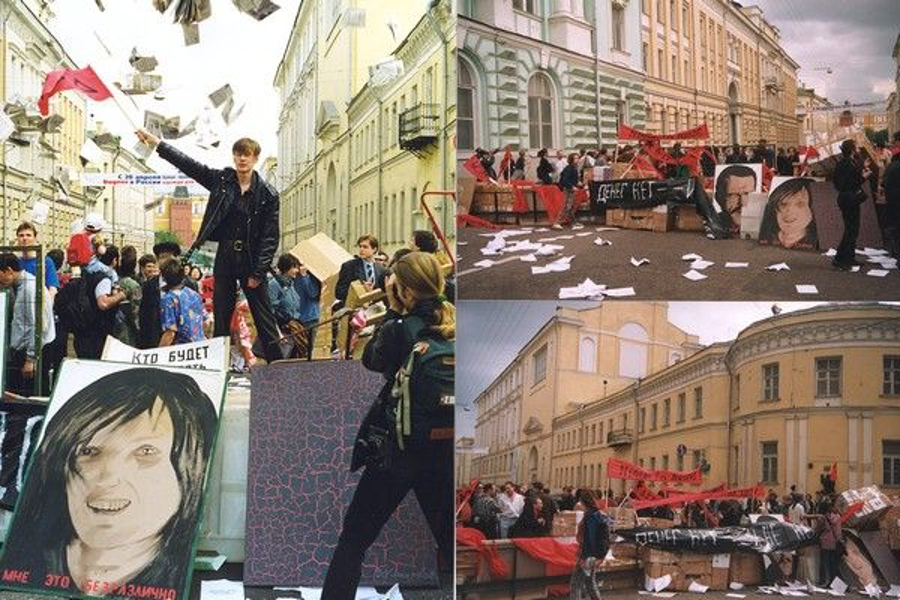Filed Under: Print > Visual arts > The Non-Governmental Control Committee, "Barricade," Bolshaia Nikitinskaia street, 1998
The Non-Governmental Control Committee, "Barricade," Bolshaia Nikitinskaia street, 1998

The protest action profiled in this artifact was organized by Anatoly Osmolovsky and Avdei Ter-Oganyan, seemingly as the culmination of (and perhaps as a break with) Osmolovsky’s prior work with Gleb Pavlovsky, Marat Guelman, and Maksim Meyer’s Effective Politics Fund between 1995 and 1996. Osmolovsky’s involvement with the Effective Politics Fund resulted in his forming the Non-Governmental Control Committee (NGCC), ostensibly as a political megaphone through which artists could address the state, and to convince members of the public to cast their vote “against everyone.”
On 23 May 1998, the NGCC created a barricade out of cardboard and artworks across Bolshaia Nikitinskaia street, about 150 meters from the Kremlin. Their stated goal was to commemorate the barricades of student uprisings at the Sorbonne in 1968, but they were also experimenting with non-traditional political and media strategies. According to a commentary on the action published in the 1998 issue of the magazine Radek, the NGCC initially demanded a monthly stipend, the total legalization of all drugs, and state-sponsored travel in perpetuity for all involved in the actions. Other demands were quickly added by people from outside the organization who spontaneously joined the protest.
Multiple artists donated works to the barricade, including Avdei Ter-Oganyan and Dmitri Vrubel. According to the organizers, approximately 300 people were involved. The central element of the piece, the Barricade, directly alluded to the Sorbonne uprising by reusing Situationist International slogans associated with the original revolt, some in the original French (e.g. Soyez réalistes, demandez l'impossible, “Be realistic, demand the impossible”), as well as other provocative banners in an anti-capitalist vein, such as “Nique ta mère [Fuck your mom]” and “There is no money.”
As the Radek piece noted, the Barricade was forcibly broken soon after the participants began marching toward the Kremlin shouting “We won!” Almost immediately, the hitherto inactive police violently attacked the protest, beating and arresting participants. Despite police violence and legal consequences for the organizers, the NGCC and critics sympathetic to it described the action as a success in their public comments. In an essay of 2 June 1998, critic Alexander Panov, writing under the pen-name “Fedor Romor,” called it a “deconstruction of Power, without violence, carnivalesque and artistic, and perhaps a bit too effective as a result.” Panov continued: “The streams of artists and students broke the dam of riot police and art historians in civilian clothes. They broke through, although street cleaners disassembled the barricade and six members of the action (including Osmolovsky and Ter-Oganyan) spent two days under arrest.”
In a paradoxical way, by ritualizing protest and its prohibition through artistic action, Barricade marked the collapse of the democratic and even anarchic possibilities opened up by the end of the Soviet Union. Although other significant protest movements would emerge over the next two decades, the impossibility of making change through peaceful demonstrations was already apparent in Barricade. Now and in the future, the state alone would speak, and understand, the language of violence.